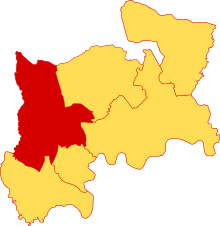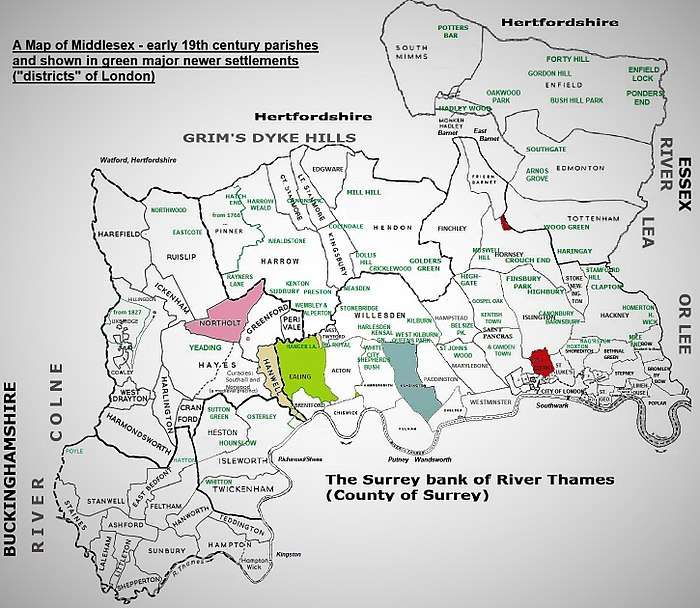Elthorne Hundred
Elthorne was a hundred (ancient subdivision) of the historic county of Middlesex, England. It was a north-west portion having these parishes:[1][2]
- Cranford, and Harlington and West Drayton small parishes north of the south-west projection, Harmondsworth
- Harmondsworth, the far south-west projection. It as such covered most of the fields and former homes of Heathrow (hamlet) taken up to become London Heathrow Airport
- Greenford, between Northolt and Perivale in the east
- Hanwell a strip parish east of Norwood Green.[n 1]
- Hayes, the south-east half of which was Norwood, a precinct from the founding of its 12th century chapel, then chapelry until its 1859 upgrade to a parish, during the early centuries seeing its Southall manor build up significantly and build its own community. The first mention of a priest in the precinct of Norwood is of Simon, the chaplain of Southall, in 1394.[n 2]
- Yeading developed late in the county in the north of Hayes proper (outside of the precinct). It saw its first mission church in 1890.
- Hillingdon, a large area, a fairly neat upright rectangle. The western parish with the main indent of the Colne, a braided river.
- Ickenham, a small parish north-east of Hillingdon and north-west of Hayes
- Northolt between Ruislip and Hayes[n 4]
- Perivale, narrowly the bulk and extreme of the small eastern sub-projection
- Harefield, with Ruislip the northern projection
- Ruislip, with Harefield the northern projection. Parent parish of Eastcote and Northwood.

It thus closely corresponded to the present London Borough of Hillingdon, plus the western half of the London Borough of Ealing. The eastern third of Ealing is mainly Ealing and Acton which lay in Ossulstone Hundred.
Simplification of complex shapes
.jpg)
Major roads and housing estates have simplified the borders of localities — as shown on each local street name sign in these boroughs. The complexity of many old parish borders of Elthorne hundred has been reduced. This is seen in the modern borders of the local Church of England ecclesiastical parishes, radically simplified. As to the smallest of old parishes most boundaries have greatly changed particularly Ickenham which has shifted west. Local councils have not gone so far as to redefine street signs on the basis of equal-electorate electoral wards. They locally take heed of a fusion of long history, wards and numbered postal districts.[8]
See also
- UB postcode area, a similar area but which excludes Ruislip and its progeny (particularly Eastcote and Northwood, see HA postcode area). Most of the UB numbered divisions are loosely based on the original parishes, redrawn for post service convenience. Harmondsworth by the 20th century attached to other Middlesex areas, such as the Staines Rural District which existed from 1894 to 1930. London Heathrow airport which took much of its area as well as parts of Hatton (a hamlet of East Bedfont) and Stanwell is in the TW postcode area under Hounslow post town.
References and notes
- References
- "Table Of Population 1801–1901". British History. Retrieved 1 May 2011.
- Diane K Bolton, H P F King, Gillian Wyld and D C Yaxley, 'The hundred of Elthorne (continued)', in A History of the County of Middlesex: Volume 4 in the Victoria County History collaborative historians' work ed. T F T Baker, J S Cockburn and R B Pugh (London, 1971), p. 1. British History Online http://www.british-history.ac.uk/vch/middx/vol4/p1 [accessed 16 May 2018].
- Diane K Bolton, Patricia E C Croot and M A Hicks, 'Ealing and Brentford: Churches, Brentford', in A History of the County of Middlesex: Volume 7 ed. T F T Baker and C R Elrington (London, 1982), pp. 153-157. British History Online http://www.british-history.ac.uk/vch/middx/vol7/pp153-157 [accessed 17 May 2018].
- Diane K Bolton, H P F King, Gillian Wyld and D C Yaxley, 'Norwood, including Southall: Roman catholicism [etc]', in A History of the County of Middlesex: Volume 4, ed. T F T Baker, J S Cockburn and R B Pugh (London, 1971), pp. 52-53. British History Online http://www.british-history.ac.uk/vch/middx/vol4/pp52-53 [accessed 17 May 2018].
- Diane K Bolton, H P F King, Gillian Wyld and D C Yaxley, 'Norwood, including Southall: Sikhs', in A History of the County of Middlesex: Volume 4, ed. T F T Baker, J S Cockburn and R B Pugh (London, 1971), p. 53. British History Online http://www.british-history.ac.uk/vch/middx/vol4/p53 [accessed 17 May 2018].
- Diane K Bolton, H P F King, Gillian Wyld and D C Yaxley, 'Hillingdon, including Uxbridge: Churches', in A History of the County of Middlesex: Volume 4 ed. T F T Baker, J S Cockburn and R B Pugh (London, 1971), pp. 87-91. British History Online http://www.british-history.ac.uk/vch/middx/vol4/pp87-91 [accessed 17 May 2018].
- Diane K Bolton, H P F King, Gillian Wyld and D C Yaxley, 'Northolt: Introduction', in A History of the County of Middlesex: Volume 4, ed. T F T Baker, J S Cockburn and R B Pugh (London, 1971), pp. 109-113. British History Online http://www.british-history.ac.uk/vch/middx/vol4/pp109-113 [accessed 17 May 2018]
- Map of Ickenham parish Church of England. Accessed 17 May 2018
- Notes
- In the centuries until their powers were curtailed the Manorial Court of Boston Manor to the south-east gave suit to (was subject to the aegis of) the Hundred Court. The most built up part of the old manor immediately contributed to Brentford. Specifically the townspeople of New Brentford, founded around St Lawrence's Hospital in the old manorial land in 1179, were to worship at Hanwell on the four principal feasts and to be buried there, except the infirm, chaplains, and their servants. Offerings, tithes (but a smaller portion after c.1660) and an annual donation of wax went from the curate/curacy to the rector of Hanwell. Around 1660 New Brentford, already governed by its own vestry, was made a separate parish. In 1714 the rector of Hanwell managed to assert his right to the hay tithes from Boston manorial demesne but in 1744 he gave up the small tithes of New Brentford, all hay tithes except those from Boston demesne, and all offerings. In 1961 the parish of St. Lawrence, New Brentford, was amalgamated with St. George's and St. Paul's, Old Brentford to form the united parishes of Brentford in the Church of England.[3]
- Southall has a rich array of non-Anglican places of worship. A Sikh temple on Southall Green opened in 1963. The gurdwara was moved to another site in Southall in 1967, the old site hosting the Roman Catholic church which had had a temporary succession of churches from 1903. At least 11 other denominations of churches since 1878 have served Southall and Norwood, an unusual number outsite of a city centre, partly reflecting the diverse nationalities of founders, such as in the Gospel Hall movement.[4][5]
- Liberally described in 1547 as a vicarage valued at £5
- From at least as early as the 18th century two detached areas of Northolt parish lay in Greenford. The larger area, comprising 47 a. was the west of Greenford village immediately north of the Ruislip road and west of Oldfield Lane. A further 2½ a., called Mill Field in 1775, lay along the southern boundary of Greenford. These detached parts were transferred to Greenford in 1882 and 1887.[7]

.jpg)